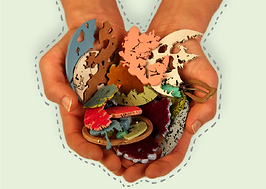On Friday I was very Privileged to experience a class at the Make: Shift: Do Event in DJCAD (that’s Duncan of Jordonson College of Art and Design for non DJCADers) this was organised by the Craft Council in Partnership with the Institute of making and the Victoria and Albert Museum (V&A) and also with Ultimakers GB. The Make: Shift: Do celebrates Digital Innovation and design and craft when I read about this on multiple social network sites (because Im obviously in the loop) I became very excited at the opportunity of the classes and so I began reading what was to offer and since I am a creative jewellery student like a magpie who sees shiny things my eyes also drew upon this shiny thing called “Smart Materials” which was to be good for Jewellery and Textile students. This seemed intresting as they promised in description:
“Smart materials, such as colour changing pigments can be used to bring an interactive, responsive dimension to fabrics, papers and other materials. Join Smart jewellery designers Beth and Kathy, to explore the exciting design potential that these materials offer for jewellery and textile design. Try using colour-changing dyes, conductive yarns, resin and silicone to make mini swatches and bold, playful forms that respond to heat, light and moisture. ”
As soon as colour changing dyes and conductive yarns were mentioned I swooped at the chance and bought my £4 ticket.
As soon I got there I was welcomed by two lovely (yet familiar) tour guides who showed us were to go for the workshop, since I am a new student at DJCAD I am always exploring new places in the building so being shown the textile department I felt like walking a strangers house as everything was just new and exciting from the work displayed on the coridors to inside the rooms but im not hear to rave about how good textiles is. So as I go in Beth and Kathy introduce themselves Beth is a jewellery designer in her second year artist in residence at DJCAD and Kathy also does Jewellery. As they were talking I couldn’t help but look around the table as I was faced with marvellous and vibrant colours the set up just looked so experimental and I couldn’t wait to see what they wanted us to do!
They explained there are two types of paint Thermo-Chromic Paint which changed colour when temperature reached between 24-31 degrees, these paints can be mixed which of these paints as I experimented with using a variety of colours including blue and silver, red and yellow, pink and purple and I noticed when mixing these colours together and applying heat to dry them it almost looked like they reverted back to what you started with ie. If you mixed purple and pink I got a darker purple and when heat was applied the purple turned significantly lighter. This was very fun because it would encourage you to experiment more with colour and have endless possibilities and design around these materials. Personally I felt like I was a little girl in art class because I was mixing colours and rushing to the hair dryers being surprised each time (yeah sure its weird but someone has to make the oooo and ahhh! sounds!)
The other type of Paint was Photo chromic which changes in the sunlight this partially worked for using yellow paint in the silicon. I was very startled at this because when I lifted the tub of paint written yellow inside was white so I questioned whether or not they just used the tub that yellow on it because they ran out of tubs but they assured me it was the correct paint. Once I applied the paint to the Silicon and mixed it and waited for it to dry they placed under the light and you could see a slight colour of yellow but remember were in Scotland and Sunlight is a blessing (which is why were all pale!)
I also tried out screen printing for the first this was very fun as I had herd of it before but never really tried it or expected the equipment to be large! But truthfully this was really fun as I got card cut out some shapes and mixed the Thermo chromic paints and applied them at the top of the template flipped the screen over, and the “sqeegie” angle it and move it back and fourth, and tada!!! a print is born … cool!
The Next thing we did was make silcicon with the paints this was slightly more disgusting this gets everywhere and I recommend (STRONGLY!!!) to wear gloves as your hands will get covered and washing them does nothing!!! You feel slimy and gross! (trust me im an artist!) other than that you keep the ratio of silicon and hardener 1:1 and put them into moulds and its as easy as that!
These fancy prints sit above my radiator in my room as I watch them change colour everyday (well as much as a person can watch paint dry!) but in all seriousness I really enjoyed myself learning about smart materials and what they can do ill defiantly keep them in mind when doing my jewellery work and what I can incorporate as just now im open to experimentation as I guess what all designer look for a new way of inventing themselves and updating new skills and ways to improve. As at some point you will be bored of doing the same thing so its nice to try something different at least once in a while and im glad Dundee has things like this for the public and for professional designers as they too probably don’t know everything just like us.
-Kimmy xxx



Comments